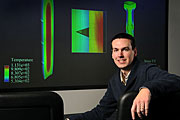- Number 340 |
- June 27, 2011
Young minds develop simple software to solve complex problems

Derek Gaston's MOOSE
(Multiphysics Object Oriented
Simulation Environment) gives
researchers a tool that could
accelerate nuclear fuels
experiments by years.
A young computer techie and his team of software gurus have developed a computational framework that could accelerate nuclear fuels experiments by years. At DOE's Idaho National Laboratory, Derek Gaston has developed tools to enable effortless creation of high-performance engineering multiphysics simulation capabilities.
More simply, he has found an easier way for computers to solve equations and create simulations, thereby focusing research methods. It’s a software program he has dubbed MOOSE (Multiphysics Object Oriented Simulation Environment).
As leader of the Computational Frameworks Group in INL's Fuels Modeling and Simulation Department, Gaston works in the field of multiphysics and has developed tools being used by laboratories and research institutions around the country to create cutting-edge simulation codes. His work earned him this year’s Early Career Achievement Award at the 15th Annual INL Honors Banquet. The award recognizes a high-potential individual under the age of 35. Gaston is 29, and he’s been enthralled with computers since he saw his first one as a Missouri first-grader.
When Gaston accepted a job at INL three years ago, he was allowed the freedom to work on the concept that led to MOOSE. The resulting high-performance computing framework is being used to support the DOE with future nuclear plant research, the Light Water Reactor Sustainability program and geothermal technology programs.
MOOSE is a tool for working on many pieces of the nuclear reactor fuel lifecycle. It can enlighten fuel fabrication and fuel performance to try to extend the life of current light water reactors while looking toward the future by simulating new reactor designs that can give cleaner, more sustainable energy. The copyrighted MOOSE is also being used in non-nuclear settings such as environmental remediation of chemical spills, carbon sequestration and even oil shale recovery processes.
Using MOOSE, simulation "is a very rapid process," Gaston said. For instance, a geophysicist who wants to map the flow of water through the bedrock of the aquifer can do so in weeks instead of years. "MOOSE minimizes the development time for creating new engineering simulations," Gaston said.
Before coming to INL, Gaston worked for two years on multiphysics simulation capabilities at Sandia National Laboratories in Albuquerque. He had done an internship at Sandia and applied for a job because of the "great experience there." He was hired after receiving his bachelor’s degree, and Sandia "promptly sent me to University of Texas at Austin to obtain my master's degree" in computational applied mathematics.
Gaston grew up in a small town in southwest Missouri and earned a bachelor's degree in computer science from University of Missouri in Rolla. He worked for the Central Intelligence Agency in Washington, D.C., for nine months doing database work.
Outside of work, Gaston turns to photography for fun and relaxation. He has about 10,000 photos stored online. His focus is landscape photography, but his online albums include family vacations, wildlife and much more.Submitted by DOE's Idaho National Laboratory
